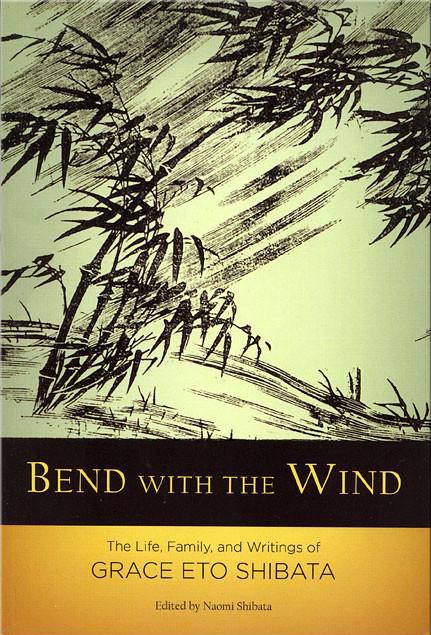Bend with the Wind: The Life, Family, and Writings of Grace Eto Shibata (book)
Memoir of a Nisei woman—though written in the third person—that covers a nearly one hundred year history of a prominent San Luis Obispo area farming family and that ends with the author's graduation from college at age seventy-four.
Grace Eto (b. 1925) was the youngest of eight children (seven of them girls) of Tameji and Take Eto. Issei from Kumamoto Prefecture, the Etos became successful farmers in Los Osos, around twelve miles east of San Luis Obispo along the Central California coast. The first chapter of the book covers Grace's happy childhood alongside her many siblings. After the attack on Pearl Harbor, Tameji is one of the Issei community leaders who was arrested and held in a series of internment camps over the next several months. Take and the unmarried daughters move in with one of Grace's older sisters and her husband, who live in Military Area 2 , east of the initial area from which Japanese Americans were initially excluded. But three months later, they are forced to move from there as well. They opt to join another sister who has become a nurse at Manzanar . Grace and another sister eventually leave Manzanar early in 1943 to join another sister and her husband who buy a farm in eastern Oregon. But after a few month, Grace moves to Boise where she becomes a live-in housekeeper and goes to college. She rejoins the family in Los Osos when they return in 1945. Later chapters cover her marriage to Yoshimi Shibata, whose family grows flowers in Mt. Eden, California, and their business and family life that comes to include three children. When the children leave the house, Grace manages a new floral supply arm of the family business. Upon her retirement, she attends Mills College—where three of her sisters had attended—and eventually graduates in 2000. The book includes a postscript that updates the story of various family members and the family business; several of Grace's writings (an affectionate biography of Take and three autobiographical short stores set on the farm prior to WWII that she wrote while at Mills); copies of both family and general documents centering on the incarceration period; and a family timeline.
The introductory materials—a Foreword by Dan Krieger, a Preface by Arthur A. Hansen, and an Introduction—provide some background on the book. At the urging of her family, Grace had agreed to do a memoir and worked with her daughter, Naomi Shibata, on it. Described by Naomi in the introduction as "an expansive oral history," Grace and Naomi also interviewed three of Grace's older sisters, visited Manzanar and other sites important to her life story, looked at family photographs to jog memory (many of which are reproduced in the book), and sought additional information in archives and online. Though a memoir, the voice in the main body of the book is of an omniscient third person narrator that refers to Grace in the third person.
Bend with the Wind is the third memoir by a member of the Eto/Shibata family. Grace's husband, Yoshimi Shibata, wrote his own memoir Across Two Worlds: Memoirs of a Nisei Flower Grower (2006), while Grace's nephew edited and published his mother (and Grace's sister) wartime memoir Nurse of Manzanar: A Japanese American's World War II Journey (2009). Each of the volumes was privately printed, though all are available to some extent at libraries and through online retailers.
Might also like Dandelion Through the Crack/Kiyo's Story by Kiyo Sato; We the People: A Story of Internment in America by Mary Tsukamoto; Looking Like the Enemy: My Story of Imprisonment in Japanese-American Internment Camps by Mary Matsuda Gruenewald
| Author | Grace Eto Shibata, Naomi Shibata (editor) |
|---|---|
| Pages | 242 |
| Publication Date | 2014 |
